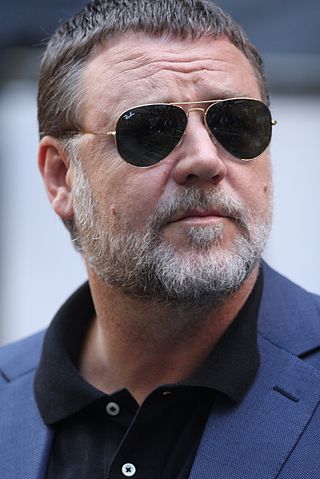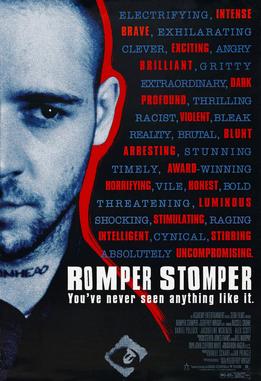Related Research Articles

Phoenix is a Logie Award-winning Australian crime drama television series broadcast by the Australian Broadcasting Corporation from 1992 to 1993. It was created by Alison Nisselle and Tony McDonald.

Russell Ira Crowe is an actor. He was born in New Zealand, spent 10 years of his childhood in Australia, and resided there permanently by age 21. He has earned various accolades, including an Academy Award, two Golden Globe Awards, and a British Academy Film Award. Crowe is considered by many to be one of the greatest actors of the 21st century.
A home front or homefront is the civilian populace of the nation at war as an active support system for its military.

Bruce Robert Spence is a New Zealand-born Australian actor. Spence has amassed over 100 film and television credits and has also acted in theatre.

Romper Stomper is a 1992 Australian drama film written and directed by Geoffrey Wright in his feature film directorial debut. The film stars Russell Crowe, Daniel Pollock, Jacqueline McKenzie, Tony Le-Nguyen and Colin Chin. The film tells the story of the exploits and downfall of a neo-Nazi group in blue-collar suburban Melbourne. The film was released on 12 November 1992.
The Henderson Kids is an Australian television series made by Crawford Productions for Network Ten between 1985 and 1987. It was created and storylined by Roger Moulton, who also wrote 5 episodes in the first series and 2 episodes in the second series.

The National Film and Sound Archive of Australia (NFSA), known as ScreenSound Australia from 1999 to 2004, is Australia's audiovisual archive, responsible for developing, preserving, maintaining, promoting and providing access to a national collection of film, television, sound, radio, video games, new media, and related documents and artefacts. The collection ranges from works created in the late nineteenth century when the recorded sound and film industries were in their infancy, to those made in the present day.

Discovery Atlas is a documentary television series on the Discovery Channel and Discovery HD Theater which focuses on the cultural, sociological, and natural aspects of various countries by exploring their different peoples, traditions, and lands. The documentary follows the lives and individual struggles of locals, while taking in-depth looks at the countries' history and culture. Eight episodes have been broadcast so far on the Discovery Channel: the first episode, Discovery Atlas: China Revealed aired October 1, 2006, and was followed by Discovery Atlas: Italy Revealed, Brazil Revealed, and Australia Revealed. The most recent episodes have been focused on France, Japan, Egypt and Russia.

"I Was Only 19" a song by the folk group Redgum. The song was released in March 1983 as a single, which hit number one on the national Kent Music Report Singles Chart for two weeks. It was also recorded for Redgum's live album Caught in the Act released in June, which stayed in the top 40 of the Kent Music Report Albums Chart for four months. Royalties for the song go to the Vietnam Veterans Association of Australia. It is in the Australasian Performing Right Association's Top 30 Australian Songs of all time. "I Was Only 19" became the most widely recognised song by the band.
Anzacs is a 1985 Australian five-part television miniseries set in World War I. The series follows the lives of a group of young Australian men who enlist in the 8th Battalion (Australia) of the First Australian Imperial Force in 1914, fighting first at Gallipoli in 1915, and then on the Western Front for the remainder of the war.
World War II in Colour is a 13-episode British television docuseries recounting the major events of World War II narrated by Robert Powell. It was first broadcast in 2008–2009. The series is in full colour, combining both original and colourized footage. The show covers the Western Front, Eastern Front, North African Campaign and the Pacific War. It was on syndication in the United States on the Military Channel.

Redfern Now is an Australian drama television series that first aired on ABC1 in 2012. It follows the lives of six Aboriginal Australian families living in the urban hub of Redfern, Sydney. The series provides insight into contemporary issues facing Aboriginal Australians, including lack of employment and mental illness, which are positioned as direct ramifications of colonialisation and the Stolen Generations. Produced by Blackfella Films as part of the ABC's Indigenous Department, the show is the first series to be 'commissioned, written, acted and produced by Indigenous Australians'. f5 in The series' release contributes to widespread public debate surrounding Indigenous representation in the Australian media.

The Water Diviner is a 2014 drama film starring and directed by Russell Crowe, in his directorial debut, and written by Andrew Anastasios and Andrew Knight. It is loosely based on the book of the same name by Anastasios and Dr. Meaghan Wilson-Anastasios. The film follows an Australian farmer, Joshua Connor (Crowe), who travels to Turkey soon after World War I to find his three sons who never returned. It also stars Olga Kurylenko, Jai Courtney, Cem Yılmaz, Yılmaz Erdoğan, and Jacqueline McKenzie.
ANZAC Girls is an Australian television drama series that first screened on ABC1 on 10 August 2014. The six-part series tells the rarely told true stories of the nurses serving with the Australian Army Nursing Service at Alexandria, Lemnos, and the Western Front during the First World War. The series is based on Peter Rees' book The Other ANZACs as well as diaries, letters, photographs and historical documents. The series was written by Felicity Packard and Niki Aken, produced by Screentime, and filmed in South Australia.
Graham Shirley is an Australian author, researcher, curator and filmmaker best known for his work in the area of Australian film history.
The Road to Kokoda is a 1942 Australian documentary. Much of the footage shot by Australian war photographer Damien Parer (1912–1944) also appears in Kokoda Front Line!.
Aunty Jack Introduces Colour is a one-off television special edition of The Aunty Jack Show, broadcast on ABC television on the night of 28 February 1975. It was created two years after The Aunty Jack Show finished, and featured the main character, Aunty Jack, played by Grahame Bond, even though she had been killed off in the last season in 1973. The episode was five minutes long and was the first show on ABC television to be broadcast in colour.
Raymond Charles Argall is best known as a cinematographer and director for both film and television. He has also worked as an editor. His multi-award-winning feature film Return Home (1990) is regarded by many critics as an Australian cinema classic. Argall served on the board of the Australian Directors Guild (ADG) for sixteen years, holding the position of president from 2006 to 2015 and secretary from 2015 to 2017. In 2016, Argall launched a business restoring archival films through his production company Piccolo Films. In 2018 the ADG presented him with its prestigious Cecil Holmes Award.

Daniel Reynaud is an Australian historian whose work on Australian war cinema and on Australian World War I soldiers and religion has challenged aspects of the Anzac legend, Australia’s most important national mythology built around the role of Australian servicemen, popularly known as Anzacs
Bert Ive (1875–1939) was a British-born Australian cinematographer, who was the first long-term cinematographer and still photographer in Australia. During his career as a film photographer for the federal government from 1913 to 1939, he frequently travelled across Australia to photograph the country's landscapes, industries, people and famous events. His motion pictures and still photos were used to promote Australia to the rest of the world.
References
- ↑ "Archived copy". Archived from the original on 12 February 2014. Retrieved 18 January 2014.
{{cite web}}: CS1 maint: archived copy as title (link) Accessed 2014-01-18 - ↑ nfsa.gov.au http://nfsa.gov.au/collection/film-australia-collection/program-sales/search-programs/program/?sn=8578 . Retrieved 8 January 2014.
{{cite web}}: Missing or empty|title=(help)[ title missing ] - ↑ "The Colour of War – The Anzacs – Review". www.smh.com.au. 26 November 2004. Retrieved 18 January 2014.
- ↑ "2005 Winners – Screen Music Awards". Australasian Performing Right Association (APRA). Archived from the original on 8 March 2011. Retrieved 16 May 2010.